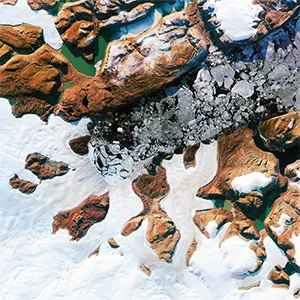
Hidden lake explodes under the Greenland ice sheet, creating a massive crater
A hidden lake beneath the Greenland ice sheet at Harder Glacier suddenly burst from deep beneath the ice. The water exploded upwards, cracked the thick ice above, and shot out across the surface.
In just ten days, the lake released 23.8 billion gallons (90 million cubic meters) of water. That’s the equivalent of nine hours of Niagara Falls water pressure running at full force.
The result? An 270 foot (85-meter) deep crater formed, stretching across 0.77 square miles (2 square kilometers) of ice.
And that was just the start.
Understanding ice sheets – the basics
The Greenland ice sheet is one of the most massive bodies of ice on Earth, second only to Antarctica. It covers roughly 80% of Greenland’s surface and holds enough frozen water to raise global sea levels by about 23 feet (7 meters) if it melted entirely.
What’s alarming is that it’s shifting, melting, and breaking down faster than scientists once expected. Warm ocean currents gnaw at it from below, while rising air temperatures accelerate melting from above.
The meltwater from Greenland is already contributing significantly to sea level rise, with rates that have more than doubled over the last few decades.
The freshwater flowing into the North Atlantic is also disrupting ocean circulation patterns, including the Atlantic Meridional Overturning Circulation (AMOC), which helps regulate the climate from the equator to Europe.
Greenland ice shattered after lake burst
Farther downstream, researchers saw something even more shocking. A patch of once-smooth ice now looked like a war zone.
Deep cracks split the surface. Ice blocks, as tall as a five-story building 82 feet (25 meters), stood torn from the ground.
Water had scoured the area clean. The flood had carved through about 2.3 square miles – twice the size of New York’s Central Park.
Dr. Jade Bowling from Lancaster University, who led the study, was stunned when she first saw the data.
“When we first saw this, because it was so unexpected, we thought there was an issue with our data. However, as we went deeper into our analysis, it became clear that what we were observing was the aftermath of a huge flood of water escaping from underneath the ice.”
The study appeared in Nature Geoscience. It sheds light on how little we truly know about the watery world beneath Greenland’s ice.
Water surged upward through solid ice
Normally, scientists expect meltwater to flow down from the surface to the bottom of the ice sheet. This flood flipped that idea.
Water traveled upward. It smashed through frozen layers as it forced its way out. This kind of movement wasn’t in any model.
And the location? Even stranger. Models said the ice bed there should’ve been frozen solid. But the lake still drained. The team thinks pressure cracked the ice bed itself, opening a path for the water to shoot upward.
“The existence of subglacial lakes beneath the Greenland Ice Sheet is still a relatively recent discovery and, as our study shows, there is still much we don’t know about how they evolve and how they can impact on the ice sheet system,” Dr. Bowling explained.
Monitoring Greenland ice and lake bursts
To catch all this, the team turned to satellites. They used high-res 3D maps from the ArcticDEM project. All of the data was combined from ESA’s CryoSat, Sentinel-1 and -2, and NASA’s ICESat-2. Without this satellite view, they wouldn’t have known the event even happened.
“This research demonstrates the unique value of long-term satellite measurements of Earth’s polar ice sheets which, due to their vast size, would otherwise be impossible to monitor,” noted Professor Mal McMillan.

“Satellites represent an essential tool for monitoring the impacts of climate change, and provide critical information to build realistic models of how our planet may change in the future. This is something that all of us depend upon for building societal resilience and mitigating the impacts of climate change.”
Greenland lake and climate models
Climate models didn’t see this coming. They didn’t expect frozen beds to fracture. They didn’t predict water flowing upward. But it happened. And if melt events like this become more common, we need better models.
Surface melt is increasing as the planet warms. More meltwater could end up stored beneath the ice. More pressure could build. More cracks could form. More explosive floods could follow.
“Given the control that subglacial hydrology has on the dynamics of the ice sheet, it is critical that we continue to improve our understanding of these hidden, and poorly understood, hydrological processes,” co-author Dr. Amber Leeson warned.
Global effort required
This wasn’t one lab’s discovery. Scientists from the U.K., Europe, and the U.S. worked together. The U.K. Natural Environment Research Council, ESA, and UKRI funded the work.
“This discovery is remarkable, and we’re proud that our Science for Society 4D Greenland project has played a key role in making it possible,” noted ESA’s Diego Fernandez.
“This result adds to the body of knowledge we are establishing through the ESA Polar Science Cluster on how the Arctic is changing in response to increased warming,” he stated.
Fernandez remarked that gaining insight into the Arctic’s hydrology is crucial for understanding the ways in which it is changing, and for predicting how the ice sheet will contribute to global sea-level rise in a warming climate.”
Future Greenland lake bursts
The ice sheet isn’t just melting. It’s breaking apart in ways we didn’t expect. Meltwater isn’t always calm. It can rip through solid ice and upend what we think we know.
Greenland just gave us a warning. We need to listen.
The study is published in the journal Nature Geoscience.
—–
Like what you read? Subscribe to our newsletter for engaging articles, exclusive content, and the latest updates.
Check us out on EarthSnap, a free app brought to you by Eric Ralls and Earth.com.
—–













